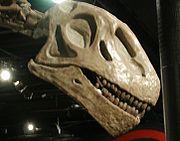Diapsid
| Diapsid reptiles Fossil range: Carboniferous-Recent |
||||||||
|---|---|---|---|---|---|---|---|---|
 Omeisaurus tianfuensis
|
||||||||
| Scientific classification | ||||||||
|
||||||||
| Orders | ||||||||
|
See text. |
Diapsids ("two arches") are a group of reptiles that developed two holes (temporal fenestra) in each side of their skulls, about 300 million years ago during the late Carboniferous period. Living diapsids are extremely diverse, and include all crocodiles, lizards, snakes, and tuatara. Under modern classification systems, even birds are considered diapsids, since they evolved from diapsid ancestors and are nested within the diapsid clade. While some diapsids have lost either one hole (lizards), or both holes (snakes), or even have a heavily restructured skull (modern birds), they are still classified as diapsids based on their ancestry. There are at least 7,925 species of diapsid reptile existing in environments around the world today (over 14,600 when birds are included).
Contents |
Characteristics

The name Diapsida means "two arches", and diapsids are traditionally classified based on their two ancestral skull openings (temporal fenestrae) posteriorly above and below the eye. This arrangement allows for the attachment of larger, stronger jaw muscles, and enables the jaw to open more widely. A more obscure ancestral characteristic is a relatively long lower arm bone (the radius), compared to the upper arm bone (humerus).
Systematics
Diapsids were originally classified as one of four subclasses of the class Reptilia, all of which were based on the number and arrangement of openings in the skull. The other three subclasses were Synapsida (one opening low on the skull, for the "mammal-like reptiles"), Anapsida (no skull opening, including turtles and their relatives), and Euryapsida (one opening high on the skull, including many prehistoric marine reptiles). With the advent of phylogenetic nomenclature, this system of classification was heavily modified. The Synapsids today are often not considered true reptiles, while the Euryapsida was found to be an unnatural assemblage of diapsids that had lost one of their skull openings. Some studies have suggested that this is the case in turtles as well, and that turtles are actually heavily modified diapsids, which would leave only some prehistoric forms in the Anapsida. In phylogenetic systems, birds (descendants of traditional diapsid reptiles) are also considered to be members of this group.
Well known extinct diapsid groups include the dinosaurs, pterosaurs, plesiosaurs, mosasaurs, and many more obscure lineages. The classification of most of the early groups is fluid and subject to change.
Taxonomy
- Subclass DIAPSIDA
- Order Araeoscelidia
- Order Avicephala
- Order Thalattosauria
- Order Younginiformes
- Superorder Ichthyopterygia (ichthyosaurs)
- Infraclass Lepidosauromorpha
- Order Eolacertilia
- Superorder Lepidosauria (tuatara, lizards, amphisbaenians and snakes)
- Superorder Sauropterygia (plesiosaurs and relatives)
- Infraclass Archosauromorpha
- Order Aetosauria
- Order Choristodera
- Order Phytosauria
- Order Prolacertiformes
- Order Pterosauria
- Order Rauisuchia
- Order Rhynchosauria
- Order Trilophosauria
- Superorder Crocodylomorpha (crocodiles and extinct relatives)
- Superorder Dinosauria
Phylogeny
Diapsida
|--Araeoscelida
|-?Sphodrosaurus
|-?Palacrodon
|-?Omphalosaurus
`--+--Avicephala
`--Neodiapsida
|--Apsisaurus
`--Eosuchia
|-?Younginiformes
`--+-?Claudiosaurus
|-?Ichthyopterygia
`--Sauria
|-?Thalattosauriformes
|--Lepidosauromorpha
`--Archosauromorpha
See also
External links
- Diapsida. Michel Laurin and Jacques A. Gauthier. Tree of Life Web Project. June 22, 2000.
- Diapsida Cladogram at Mikko's Phylogeny Archive
|
||||||||||||||||||